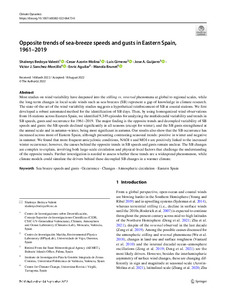Por favor, use este identificador para citar o enlazar este ítem:
http://hdl.handle.net/20.500.11765/14258
Opposite trends of sea‑breeze speeds and gusts in Eastern Spain, 1961–2019
Registro completo de metadatos
| Campo DC | Valor | Lengua/Idioma |
|---|---|---|
| dc.contributor.author | Bedoya Valestt, Shalenys | es_ES |
| dc.contributor.author | Azorín Molina, César | es_ES |
| dc.contributor.author | Gimeno, Luis | es_ES |
| dc.contributor.author | Guijarro Pastor, José Antonio | es_ES |
| dc.contributor.author | Sánchez Morcillo, Víctor José | es_ES |
| dc.contributor.author | Aguilar, Enric | es_ES |
| dc.contributor.author | Brunet, Manola | es_ES |
| dc.date.accessioned | 2022-12-27T09:10:24Z | - |
| dc.date.available | 2022-12-27T09:10:24Z | - |
| dc.date.issued | 2022 | - |
| dc.identifier.citation | Climate Dynamics. 2022 | es_ES |
| dc.identifier.issn | 0930-7575 | - |
| dc.identifier.issn | 1432-0894 | - |
| dc.identifier.uri | http://hdl.handle.net/20.500.11765/14258 | - |
| dc.description.abstract | Most studies on wind variability have deepened into the stilling vs. reversal phenomena at global to regional scales, while the long-term changes in local-scale winds such as sea-breezes (SB) represent a gap of knowledge in climate research. The state-of-the-art of the wind variability studies suggests a hypothetical reinforcement of SB at coastal stations. We first developed a robust automated method for the identification of SB days. Then, by using homogenized wind observations from 16 stations across Eastern Spain, we identified 9,349 episodes for analyzing the multidecadal variability and trends in SB speeds, gusts and occurrence for 1961–2019. The major finding is the opposite trends and decoupled variability of SB speeds and gusts: the SB speeds declined significantly in all seasons (except for winter), and the SB gusts strengthened at the annual scale and in autumn–winter, being most significant in autumn. Our results also show that the SB occurrence has increased across most of Eastern Spain, although presenting contrasting seasonal trends: positive in winter and negative in summer. We found that more frequent anticyclonic conditions, NAOI + and MOI + are positively linked to the increased winter occurrence; however, the causes behind the opposite trends in SB speeds and gusts remain unclear. The SB changes are complex to explain, involving both large-scale circulation and physical-local factors that challenge the understanding of the opposite trends. Further investigation is needed to assess whether these trends are a widespread phenomenon, while climate models could simulate the drivers behind these decoupled SB changes in a warmer climate. | es_ES |
| dc.description.sponsorship | This research was funded by the following projects: IBER-STILLING (RTI2018-095749-A-I00, MCIU/AEI/FEDER,UE); and VENTS (GVA-AICO/2021/023). C.A.M was granted by Ramon y Cajal fellowship (RYC-2017–22830), and supported by a 2021 Leonardo Grant for Researchers and Cultural Creators, BBVA Foundation. | es_ES |
| dc.language.iso | eng | es_ES |
| dc.publisher | Springer | es_ES |
| dc.rights | Licencia CC: Reconocimiento CC BY | es_ES |
| dc.subject | Sea breeze speeds and gusts | es_ES |
| dc.subject | Occurrence | es_ES |
| dc.subject | Atmospheric circulation | es_ES |
| dc.subject | Eastern Spain | es_ES |
| dc.title | Opposite trends of sea‑breeze speeds and gusts in Eastern Spain, 1961–2019 | es_ES |
| dc.type | info:eu-repo/semantics/article | es_ES |
| dc.relation.publisherversion | https://doi.org/10.1007/s00382-022-06473-0 | es_ES |
| dc.rights.accessRights | info:eu-repo/semantics/openAccess | es_ES |
| Colecciones: | Artículos científicos 2019-2022 | |
Ficheros en este ítem:
| Fichero | Descripción | Tamaño | Formato | ||
|---|---|---|---|---|---|
| CD_Bedoya_2022.pdf | 23,34 MB | Adobe PDF |  Visualizar/Abrir |
Los ítems de Arcimis están protegidos por una Licencia Creative Commons, salvo que se indique lo contrario.





